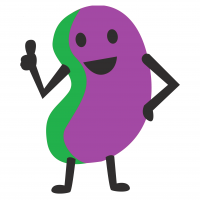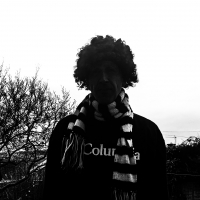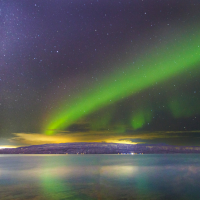Giro 2020 - Stage 13: Cervia – Monselice 192 km *Spoilers*

blazing_saddles
Posts: 22,725
in Pro race
Stage 13: Cervia – Monselice 192 km
Friday, October 16th, 10:40 BST
The 13th stage travels over the Po Plain to a finale in the Euganean Hills. The last 30 kilometres take in two short and sharp climbs before the last 11 kilometres are played out on the flat. At 192 kilometres, the route leads from Cervia to Monselice.
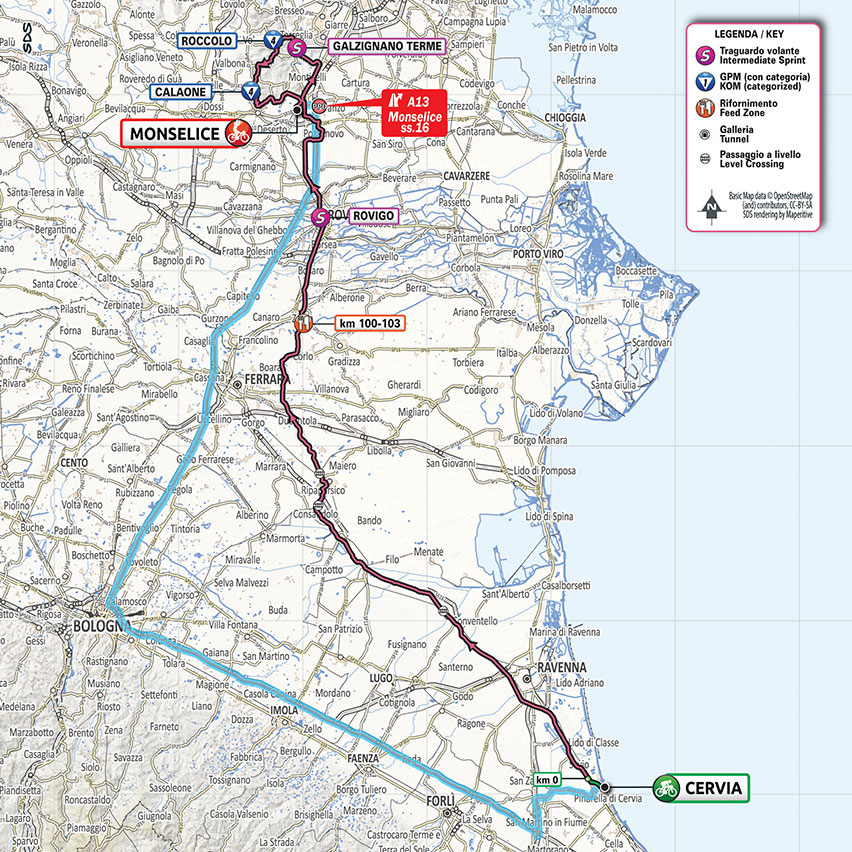
Cervia was the fist place in Italy to host the Ironman Triathlon and now the Giro d’Italia sets off from the town on the Adriatic Sea. The riders cross the Po Plain in the direction of the Alps. Not to enter the high mountains just yet. In contrast, the course of the first 155 kilometres are as flat as it gets. The only points of interest being the two intermediate sprints of Rovigo and Galzignano Terme.
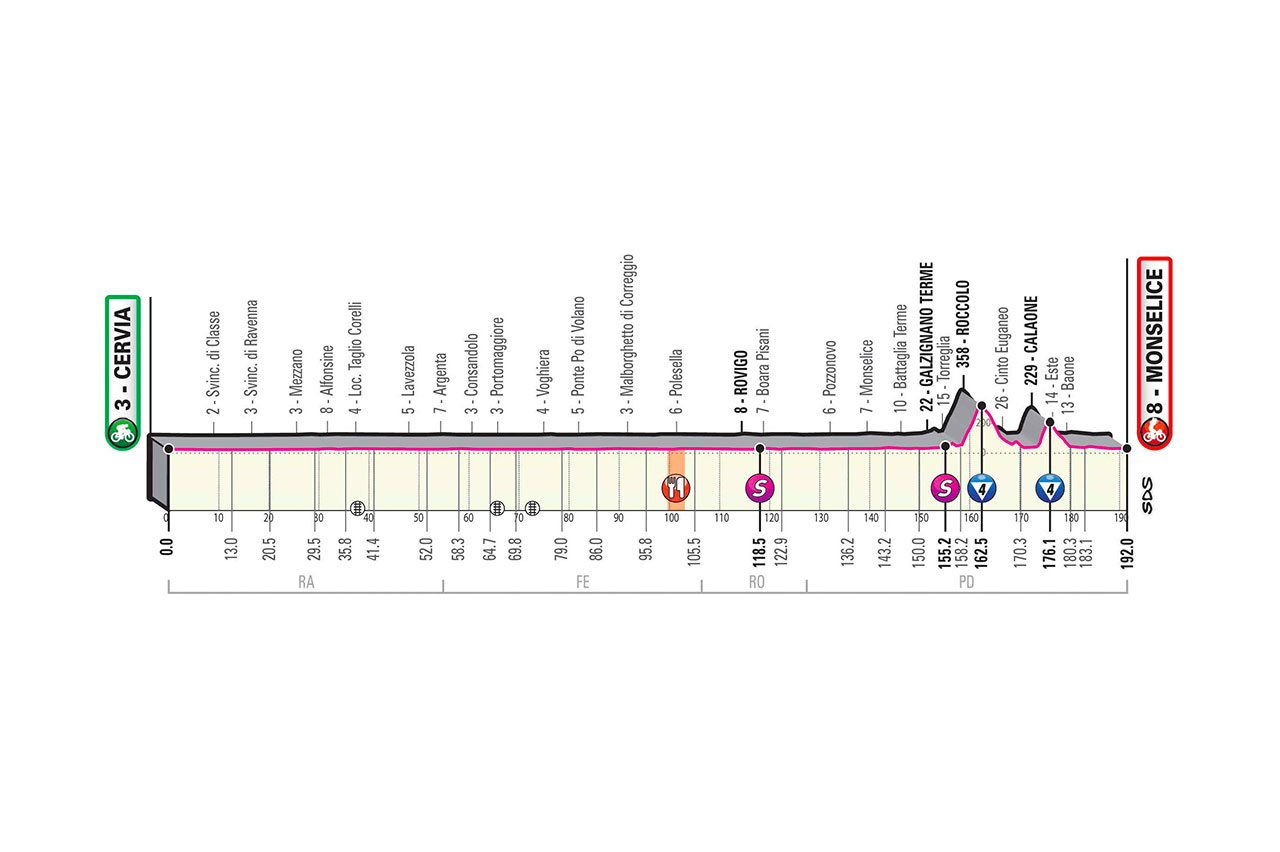
The tricky finale of the 13th stage is played out in the Euganean Hills. Rising up abruptly to heights of 300 to 600 metres northwest of Monselice, these volcanic phenomena form the picturesque backdrop for two climbs that could shake up the race. At 34 km to go the first climb of the day starts. Il Roccolo (GPM4, 4.1 km at 8.3%) is a serious climb, with a very steep ramp at 20% near the beginning and a final km at over 11% average.
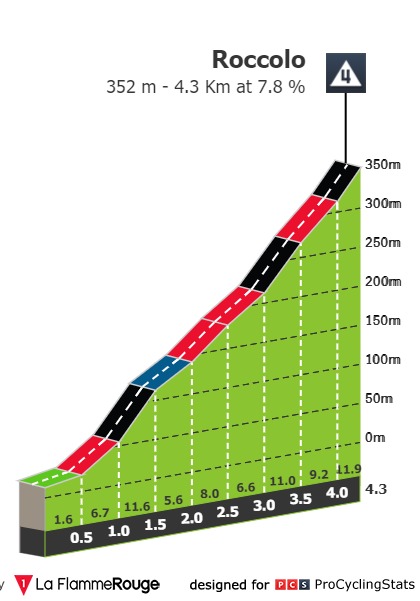
Its top is at 30 km to go, and after a pretty fast descent the peloton will only face 4 km of flat before entering the second and last climb of the day, a total of 14 kilometres.
Calaone is a 2.1 kilometres climb at 9.8%.
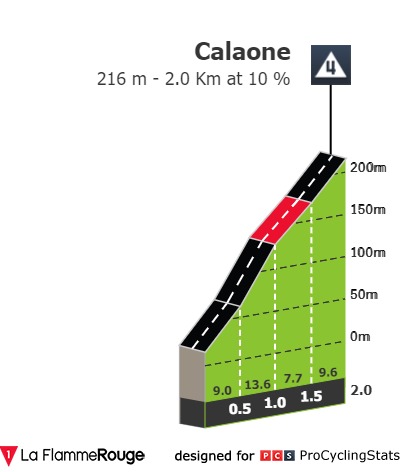
The route then descends onto the pan-flat. The descent is very fast and on wide roads, to the town of Este, from which only 12 km remain to reach Monselice.


Cervia
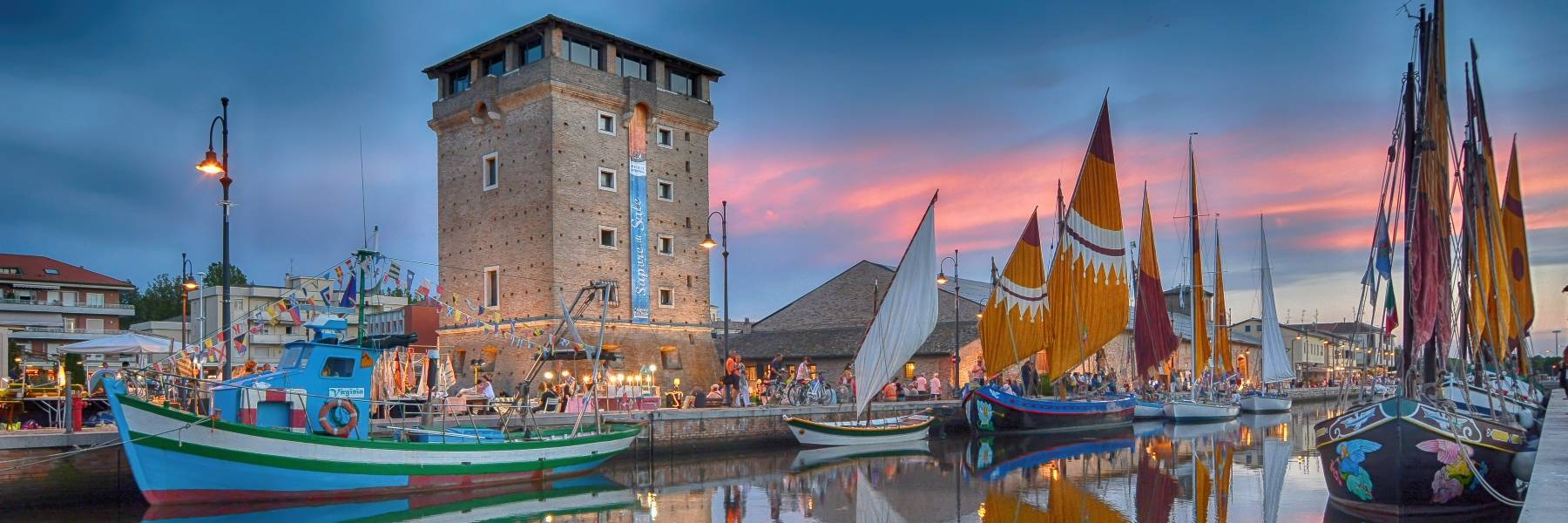
The Municipality of Cervia is situated in the region of Emilia-Romagna on a stupendous stretch of the Adriatic coast with 9 km of fine sandy beaches and shallow waters. The ancient “city of salt”, the old fishing village and the extensive pinewoods have been transformed by the development of tourism. A land of natural beauty, tradition, culture and history awaits you here, where there are many attractions if you are looking for a holiday.
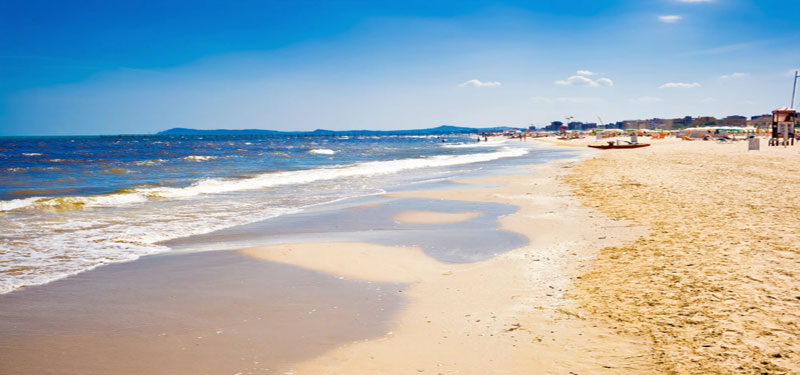
The area between Cervia and Comacchio has been preserving for more than 2,000 years big natural reserves connected with the salt production. Thousands of hectares of sweet and salt waters welcome flamingos, black-winged stilts, pied avocets and many other protected species that every year choose to stop here during their eternal migration between the hot and cold areas of the Planet.

Food
An important aspect of the tourism offer of Cervia is the food and wine. The “sweet” salt of Cervia, since 2004 a Slow Food Association product, distinguishes local cuisine in a really unique way. The best dishes to try are the traditional recipes, in particular tagliatelle and cappelletti, various sand wines of the coastal area and the more robust wines of the hill region.

Monselice
Monselice is a fortified town of ancient origin, surrounded by the enchanting scenery of the Euganean Hills. Located amid the green of the Po Valley a few kilometers south of Padua, it is nestled between two hills, Monte Ricco and Colle della Rocca. In its historic center it still retains the typical atmosphere of the past. The fortress of Frederick II, a mighty thirteenth-century fortress that dominates the Rocca (keep) Hill, has always been the historical symbol of the city which is in fact also called ‘La Città della Rocca’ (The town of the keep).

One of the most suggestive places of the town is the Via del Santuario, along which stand beautiful monuments, such as the ancient medieval Castle and the Jubilee Sanctuary of the Seven Churches from where a panoramic path leads to the top of the hill.
Food
The typical cuisine of Monselice is based on the great variety of seasonal products that grow on the Euganean Hills and combines the high quality of the local ingredients with a traditional genuine and simple cuisine. Specialties include bigoli al torchio, gnocchi al ragù,
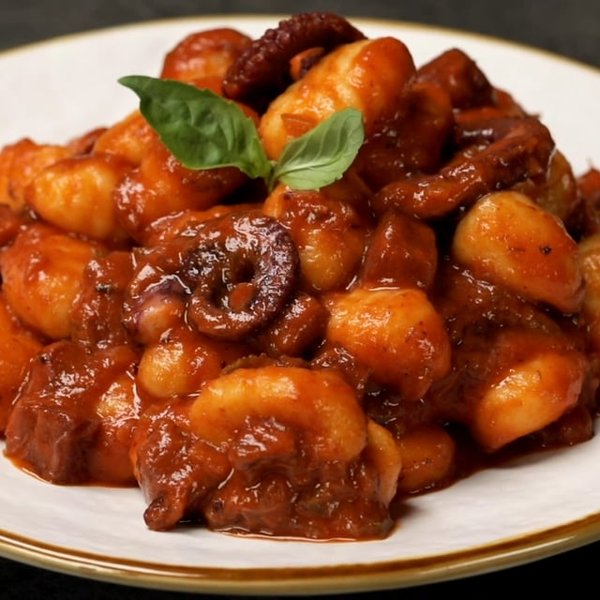
omelettes with wild herbs, musso in tocio with polenta (stewed donkey with white polenta).

Drink
Another strong point of the area is the production of wines: there are great elegant and complex red wines such as Cabernet, Merlot, Colli Euganei Rosso and white wines, Chardonnay, Pinot Bianco, Serprino, Moscato and the Fior d’Arancio.
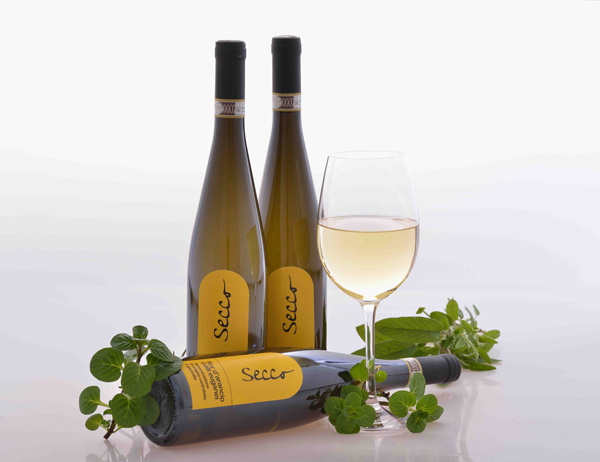
Friday, October 16th, 10:40 BST
The 13th stage travels over the Po Plain to a finale in the Euganean Hills. The last 30 kilometres take in two short and sharp climbs before the last 11 kilometres are played out on the flat. At 192 kilometres, the route leads from Cervia to Monselice.

Cervia was the fist place in Italy to host the Ironman Triathlon and now the Giro d’Italia sets off from the town on the Adriatic Sea. The riders cross the Po Plain in the direction of the Alps. Not to enter the high mountains just yet. In contrast, the course of the first 155 kilometres are as flat as it gets. The only points of interest being the two intermediate sprints of Rovigo and Galzignano Terme.

The tricky finale of the 13th stage is played out in the Euganean Hills. Rising up abruptly to heights of 300 to 600 metres northwest of Monselice, these volcanic phenomena form the picturesque backdrop for two climbs that could shake up the race. At 34 km to go the first climb of the day starts. Il Roccolo (GPM4, 4.1 km at 8.3%) is a serious climb, with a very steep ramp at 20% near the beginning and a final km at over 11% average.

Its top is at 30 km to go, and after a pretty fast descent the peloton will only face 4 km of flat before entering the second and last climb of the day, a total of 14 kilometres.
Calaone is a 2.1 kilometres climb at 9.8%.

The route then descends onto the pan-flat. The descent is very fast and on wide roads, to the town of Este, from which only 12 km remain to reach Monselice.


Cervia

The Municipality of Cervia is situated in the region of Emilia-Romagna on a stupendous stretch of the Adriatic coast with 9 km of fine sandy beaches and shallow waters. The ancient “city of salt”, the old fishing village and the extensive pinewoods have been transformed by the development of tourism. A land of natural beauty, tradition, culture and history awaits you here, where there are many attractions if you are looking for a holiday.

The area between Cervia and Comacchio has been preserving for more than 2,000 years big natural reserves connected with the salt production. Thousands of hectares of sweet and salt waters welcome flamingos, black-winged stilts, pied avocets and many other protected species that every year choose to stop here during their eternal migration between the hot and cold areas of the Planet.

Food
An important aspect of the tourism offer of Cervia is the food and wine. The “sweet” salt of Cervia, since 2004 a Slow Food Association product, distinguishes local cuisine in a really unique way. The best dishes to try are the traditional recipes, in particular tagliatelle and cappelletti, various sand wines of the coastal area and the more robust wines of the hill region.

Monselice
Monselice is a fortified town of ancient origin, surrounded by the enchanting scenery of the Euganean Hills. Located amid the green of the Po Valley a few kilometers south of Padua, it is nestled between two hills, Monte Ricco and Colle della Rocca. In its historic center it still retains the typical atmosphere of the past. The fortress of Frederick II, a mighty thirteenth-century fortress that dominates the Rocca (keep) Hill, has always been the historical symbol of the city which is in fact also called ‘La Città della Rocca’ (The town of the keep).

One of the most suggestive places of the town is the Via del Santuario, along which stand beautiful monuments, such as the ancient medieval Castle and the Jubilee Sanctuary of the Seven Churches from where a panoramic path leads to the top of the hill.
Food
The typical cuisine of Monselice is based on the great variety of seasonal products that grow on the Euganean Hills and combines the high quality of the local ingredients with a traditional genuine and simple cuisine. Specialties include bigoli al torchio, gnocchi al ragù,

omelettes with wild herbs, musso in tocio with polenta (stewed donkey with white polenta).

Drink
Another strong point of the area is the production of wines: there are great elegant and complex red wines such as Cabernet, Merlot, Colli Euganei Rosso and white wines, Chardonnay, Pinot Bianco, Serprino, Moscato and the Fior d’Arancio.

"Science is a tool for cheaters". An anonymous French PE teacher.
6
Comments
-
Still loving these previews @blazing_saddles - appreciate the time and effort you are putting into them too.2
-
Fascinating stage again. Those climbs should be too much for demare, so the turn near the end might not be a problem.0
-
they can keep the stewed donkey ! I guess that's what happens to Old Balthazaro when he's too old to pull the cart anymore. :-(BASI Nordic Ski Instructor
Instagramme0 -
Well they don't have the donkey sanctuary adverts at the girodavidof said:they can keep the stewed donkey ! I guess that's what happens to Old Balthazaro when he's too old to pull the cart anymore. :-(
"If I was a 38 year old man, I definitely wouldn't be riding a bright yellow bike with Hello Kitty disc wheels, put it that way. What we're witnessing here is the world's most high profile mid-life crisis" Afx237vi Mon Jul 20, 2009 2:43 pm1 -
Peloton all tested again, per yesterday's kerfuffle.
Ironically, EF and also Bahrain reported negative tests for the whole team yesterday evening.
Onwards and upwards I guess...................................................."Science is a tool for cheaters". An anonymous French PE teacher.0 -
At least the weather seems pretty decent today.
Not Summer like but the Sun is shining again."Science is a tool for cheaters". An anonymous French PE teacher.0 -
I feel like the weather is always miserable for the Giro.blazing_saddles said:At least the weather seems pretty decent today.
Not Summer like but the Sun is shining again.0 -
BOTD: Geoffrey Bouchard, Simon Pellaud, Simone Ravanelli, Rodrigo Contreras Pinzon, Alessandro Tonelli, Harm Vanhoucke and Lorenzo Rota
"Science is a tool for cheaters". An anonymous French PE teacher.0 -
Is this the 3rd or 4th sprint stage with a 180 turn in the last km?0
-
It seems as if JV stirred up a hornet's nest with his letter to the UCI The only problem is that he's the one now being stung.
Teams very unhappy with his request.
It also appears that he's not even at the Giro..."Science is a tool for cheaters". An anonymous French PE teacher.0 -
Matthews has yet another Covid test and again it's negative:
https://www.cyclingnews.com/news/matthews-twice-tests-negative-for-covid-19-after-giro-ditalia-exit/"Science is a tool for cheaters". An anonymous French PE teacher.0 -
I am not convinced carrying on is a great idea tbh. It's good for people to have the race to watch. God knows it makes me sane ... But I am uneasy ."If I was a 38 year old man, I definitely wouldn't be riding a bright yellow bike with Hello Kitty disc wheels, put it that way. What we're witnessing here is the world's most high profile mid-life crisis" Afx237vi Mon Jul 20, 2009 2:43 pm0
-
Would like to see the giro bubble reinforced."If I was a 38 year old man, I definitely wouldn't be riding a bright yellow bike with Hello Kitty disc wheels, put it that way. What we're witnessing here is the world's most high profile mid-life crisis" Afx237vi Mon Jul 20, 2009 2:43 pm0
-
Is the risk of carrying on any greater than hundreds of thousands of students have taken going back to uni?
[Castle Donington Ladies FC - going up in '22]0 -
I don't see why they would cancel now, but I can see why they would increase testing after Michelton Scott clearly had a problem.
It sounds like Matthews might have been one of the few unlucky ones, and it's doubly unlucky that it was a rider, so I guess there isn't time to reconfirm the initial positive test before he had to leave.0 -
It's not zero sum but additional. Sending the students back was catastrophic.. frankly ending the lock down with out adequate testing capacity was catastrophic.DeVlaeminck said:Is the risk of carrying on any greater than hundreds of thousands of students have taken going back to uni?
"If I was a 38 year old man, I definitely wouldn't be riding a bright yellow bike with Hello Kitty disc wheels, put it that way. What we're witnessing here is the world's most high profile mid-life crisis" Afx237vi Mon Jul 20, 2009 2:43 pm0 -
They have been tested twice since Monday.mididoctors said:Would like to see the giro bubble reinforced.
There have been 2 rider positives while racing for almost 2 weeks.
Astana had 2 of their initial Giro team having to be replaced, because they tested positive a week before the race, while sitting in their bubble.
What specifically do you see as a problem?
Do you think the Vuelta should start?
"Science is a tool for cheaters". An anonymous French PE teacher.0 -
If they are going to run the vuelta ...hmmm I want to see a pretty rigorous regime . Part of it is sitting an example messaging ."If I was a 38 year old man, I definitely wouldn't be riding a bright yellow bike with Hello Kitty disc wheels, put it that way. What we're witnessing here is the world's most high profile mid-life crisis" Afx237vi Mon Jul 20, 2009 2:43 pm0
-
First time I've ever seen the tenants of a break stop and the side of the road and clap the peloton as the pass! I thought they were FPKW spectators at first.1
-
Yes I was thinking the objection was the risk to the riders and staff rather than the risk of spreading the infection in Italy.mididoctors said:
It's not zero sum but additional. Sending the students back was catastrophic.. frankly ending the lock down with out adequate testing capacity was catastrophic.DeVlaeminck said:Is the risk of carrying on any greater than hundreds of thousands of students have taken going back to uni?
If it's the latter I'd have thought a national event that is already half way through and only involves hundreds of people - the size of one school - shouldn't be top of the list for stopping.
If it is the risk to the riders well I guess the choice is race or don't necessarily expect to have teams to come back to.[Castle Donington Ladies FC - going up in '22]0 -
Chance for dark horses for the stage to dump Sagan on the next climb, he doesn't look like he's finding it easy. Swift looking good and TGH also looking lively, I wonder if he might stir things up on the second climb?0
-
Could be a few attacks from the GC boys.
Not sure the sprinters can stay with a minute of the race, which is about the maximum I reckon they can pull back on the flat."Science is a tool for cheaters". An anonymous French PE teacher.0 -
Yesterday may have blunted ambition"If I was a 38 year old man, I definitely wouldn't be riding a bright yellow bike with Hello Kitty disc wheels, put it that way. What we're witnessing here is the world's most high profile mid-life crisis" Afx237vi Mon Jul 20, 2009 2:43 pm0
-
Superb by Groupama to bring Demare back but can he survive the second climb?0
-
Narvaez brimming with confidence.0
-
Little break going including TGH, purely down to UAE pace. Sagan and Swift will do well to hang on to this.0
-
TGH looking better and better the longer this Giro goes on."Science is a tool for cheaters". An anonymous French PE teacher.1
-
I hope tgh does not fade in the third"If I was a 38 year old man, I definitely wouldn't be riding a bright yellow bike with Hello Kitty disc wheels, put it that way. What we're witnessing here is the world's most high profile mid-life crisis" Afx237vi Mon Jul 20, 2009 2:43 pm0
-
Is he up to the big mountains with the GC contenders though? He could gain a few places tomorrow I suspectblazing_saddles said:TGH looking better and better the longer this Giro goes on.
0 -
One way to find outPross said:
Is he up to the big mountains with the GC contenders though? He could gain a few places tomorrow I suspectblazing_saddles said:TGH looking better and better the longer this Giro goes on.
"If I was a 38 year old man, I definitely wouldn't be riding a bright yellow bike with Hello Kitty disc wheels, put it that way. What we're witnessing here is the world's most high profile mid-life crisis" Afx237vi Mon Jul 20, 2009 2:43 pm0

